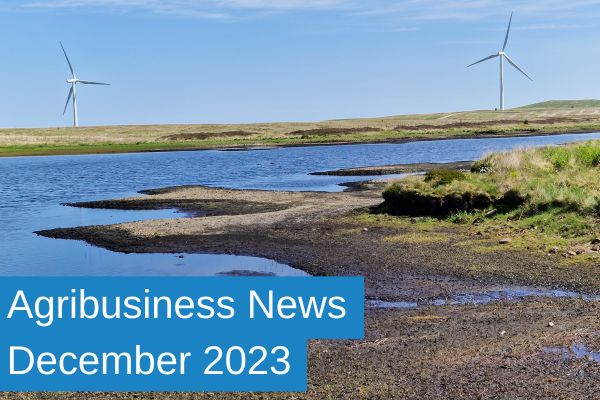Agribusiness News December 2023 – Meeting GHG Emissions Targets
30 November 2023The stakes are high for COP28, the latest climate summit in the United Arab Emirates which runs from the 30th of November through to the 12th of December. As according to a recent UN report most countries that signed up to the temperature limiting targets agreed at the Paris COP agreement in 2015 are not on track to achieve them. As part of Scotland’s efforts, Scottish agriculture has been set an ambitious target: reducing the sector’s greenhouse gas (GHG) emissions by 31% by 2032 relative to 2019 levels.
An absolute cut in emissions
This challenge is significant, as the calculation is based on gross not net emissions. Sequestration of carbon, for example by a farmer planting trees, benefits the land use, land-use change and forestry inventory, but not the agriculture inventory under current international reporting rules.
So, the broad options for Scottish farming are:
- Produce the same output with 31% less emissions (raise emissions intensity).
- No change in emissions intensity, simply reduce output.
- A halfway house that combines some reduction of output with some improvement in emissions intensity.
The first option looks preferable but seems hopelessly optimistic with current technologies. While the second, reducing agricultural output, implies less farmers and smaller processing and input sectors, so is economically unattractive, which seems to leave some variation of the final option.
Making it happen
Government efforts to improve Scottish agriculture’s carbon footprint have been largely carrot based to date. Government Grants are available for carbon auditing, soil testing and improving animal health, with FAS also funding Carbon Audit Action Plans. Farming for a Better Climate is the headline initiative for providing advice to farmers.
Anecdotal evidence suggests that uptake of grants and advice has been underwhelming. So, indications are that some stick will be used to nudge farmers to act by attaching conditions to future support. Details are expected next February.
Yet pressure to adopt more climate friendly farming practices is coming from another direction which may prove more compelling. To comply with the GHG Protocol, some retailers and processors are voluntarily introducing systems to record their Scope 3 emissions, which includes emissions from the farmers they buy from. The UK government is currently consulting as to whether to make such Scope 3 reporting mandatory (Closes 14th of December).
Nestle is committed to halving its emissions – in absolute terms – by 2030. Problem is: 95% of Nestle’s emissions come from its supply chains. Fonterra, the farmer owned New Zealand co-operative and a big supplier of dairy ingredients to Nestle has just announced plans for a 30% cut in on-farm emissions intensity by 2030 relative to 2018. However, critics point out that this is not a commitment to an absolute reduction in emissions.
Market forces
So how do we square the apparent contradiction between emissions intensity and cutting emissions absolutely? Think in terms of supply chains not overall sectors.
Some dairy farmers given a premium price will strive to cut their emissions by adopting practices that raise emissions intensity. Those producers will supply the Nestle contract helping Nestle meet its absolute reduction’s goal. That’s how it works here in Scotland. Most of the other better paying dairy contracts are also environmentally (and welfare) demanding with the productivity improvements also highlighted.
Companies in other sectors are also evolving payment structures to reward on-farm management that cut Scope 3 emissions. Suppliers of crops to McCains, Diageo and Pepsico (e.g., oats), are either contracted directly or via intermediaries like maltsters. Sainsburys introduced a premium Angus beef range this autumn sourced via ABP that is produced with 25% lower emissions.
Support changes and emissions
Removing all support would cut emissions from Scottish agriculture simply because output, especially that of the beef sector, would fall. Total removal of support is not going to happen, but direct support is likely to decline in future due to an overall squeeze in government spending and switch in funding to schemes that directly deliver public goods – like limiting climate change and improving biodiversity. These are additional to conditionality.
What happens to the level of Scottish agriculture’s emissions in coming years will therefore result from some farmers producing their outputs more efficiently, whilst others lower emissions by reducing output or exiting the industry. Ensuring that the balance is toward the former, should be the goal.
Kev Bevan, 07368 825877
Sign up to the FAS newsletter
Receive updates on news, events and publications from Scotland’s Farm Advisory Service

